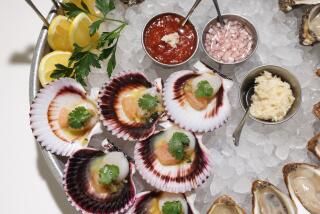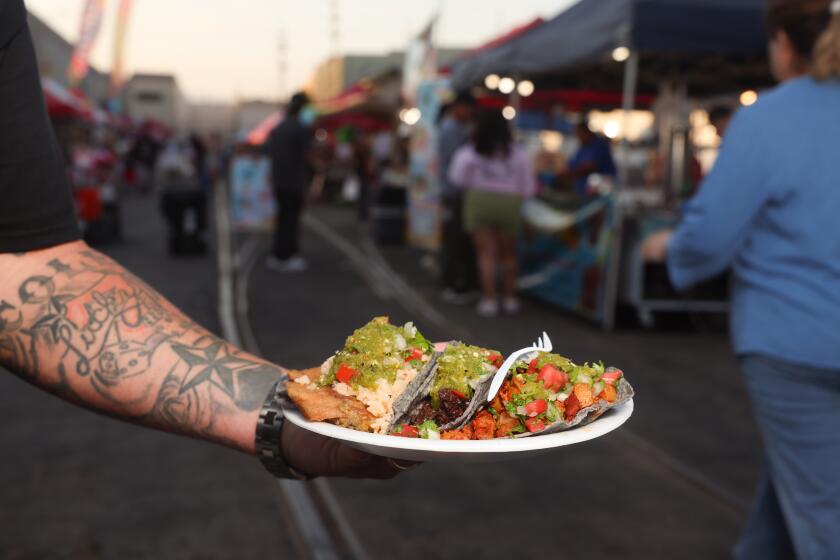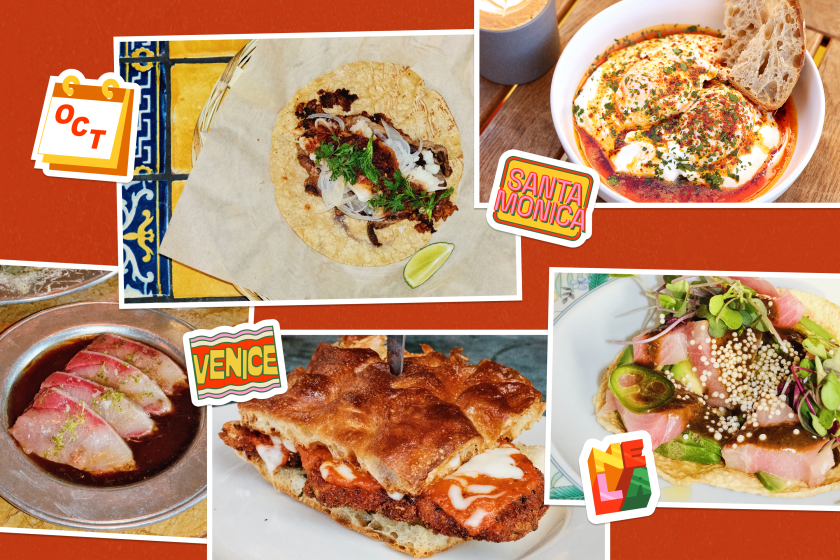Oh, Gel!
Poor gelatin! It’s made from bones, and knowing that, we can’t quite love it. Not to mention the fact that its most common manifestation is as an artificially flavored, luridly colored vehicle for sugar.
Jiggly, viscous, unaccountably echoing something physiological (what, exactly, we can’t quite say), gelatin, especially in its non-dessert forms, repels as ardently as it attracts.
Then again, many of the world’s delicacies challenge our more puritanical acculturations and taboos, confront us with willfully suppressed knowledge. Caviar is fish eggs, after all, and foie gras the liver of force-fed geese; the best cheese often harbors some form of rot. And consider the living oyster.
A friend once ordered a plate of three fish salads. When they appeared, three quivering thimbles of different jellied seafoods, she turned green at her own gills and would not so much as touch them.
And yet gelatin blooms throughout our food supply in many subtle guises: the crummy coffee-shop cheesecake, the glaze on a fresh peach pie, the pricey salmon terrine, the clear, glassy varnish on pa^te.
Jell-O started selling flavored gelatin in 1897; Knox first sold plain gelatin in 1889. Before that, writes Richard Sax in his “Classic Home Desserts,” gelatin was rendered at home from calves’ or pigs’ feet or hartshorn (shaved stag horns). After many hours of slow simmering and reduction, the resulting viscous liquid was strained through cloth and used to make “jellies.”
In medieval times, jellies were simultaneously flavored with fruit and meat. Not until the 16th century were sweet and savory jellies made distinct from one another. (Sorry, I’m just telling you what I read.)
Today, so many centuries later, gelatin has vast range. It’s used in aspic; terrines; sweet and savory mousses and mousselines; in molded salads and fruit whips; in snows and puddings; in Bavarian and other molded cream custards; in charlottes, chiffon pies, cheesecakes, parfaits; in the almond-thickened blancmange, the pure white panna cotta; in sponges, flummeries, wine jellies; in the supreme rice pudding riz a l’imperatrice; in chaud-froid sauces; in the pliable mayonnaise collee; in whipped creams stiffened for decorative purposes. Creative drinkers use gelatin to carry and disguise alcoholic beverages. (Jell-O made with vodka is 40% to 50% proof.)
Other substances gel food as well as processed bones. Isinglass, a pure form of gelatin, is extracted from the swim bladders of sturgeon and other fish. Various processed seaweeds, including agar-agar and Irish moss (carrageen), work perfectly well, although less refined forms may impart a weedy flavor.
As for the technique . . . well, sturdy old Jell-O is easy to make. Just be sure to dissolve the powder thoroughly in water right at boiling, have ready a level, cleared spot in your refrigerator and allow enough time for the stuff to set.
Working with unflavored gelatin can be trickier and immeasurably more rewarding. I vividly remember the first gelatin mold I made from scratch. I used cloudy, unfiltered apple juice, a squeeze of lemon, fresh peaches, cantaloupe and banana.
The finished product--a slick, wobbly, mouse-brown ring with orange fruit peeking out--held no visual charm, but the cold, cloudy liquid had become a soft, delicate substance, the fruit was chilled and ripe, and somehow, the molded salad had acquired an exquisite, perfumed edge not found in any individual ingredient. Flavor and texture were strangely beguiling, like something well-meaning aliens might spoon into your mouth to revive you after abduction.
In other words, the finished product tasted better than any of its parts, which is precisely the reason to make such a gelatin. It might even explain why homemakers of yore used to stir pots of hooves and knuckles forever and a day.
As it happens, the unusual enhanced flavor of my gelatin turned out to be fleeting. The next day, the same mold tasted--well, like a diluted form of Jell-O. The virtues of gelatins from scratch, I’ve learned, are perishable.
This is doubly true with gelatins made with carbonated liquids. Ginger ale gelatin has the most delightful, suspended fizziness when consumed shortly after it has set. The next day, it will be as flat as tap water.
Further experience has proven that gelatin mutes flavors in general, so it’s best to start with highly flavored juices. (No wonder Jell-O has resorted to indestructible artificial flavorings.)
After that first scratch gelatin, I made a lot more. Sweet and/or savory, fruit or meat-based--if it was liquid, I was willing to turn it into a solid.
I was in my mid-20s, my boyfriend’s mother had just given me a copy of the “The Joy of Cooking” and, as I was reading along, I came to the sentence, “Sometimes it is rewarding--and fun--to make an aspic without added gelatin.”
As I think back to that time, I can see that my life, right after graduate school when I was waiting tables at a coffee shop to pay the rent, was low on both rewards and fun, and I may have taken the sentence more to heart than authors Marion R. Becker and Irma Rombauer intended.
I bought pigs’ feet and veal knuckles. I made a spicy tomato and shrimp aspic, which some people ate with enthusiasm. Then I made poached eggs in clear veal aspic, which winnowed out even my bravest tasters; cold runny egg yolks in a trembling clear substance, I had to admit, had limited appeal. I, however, loved them, which was good, since I had to eat them all.
My most memorable and ambitious foray into savory gels back then was a Creole daube glace. I was introduced to daube in New Orleans, where it is a popular beef stew descended from the French boeuf en daube and, possibly, boeuf a la mode.
A tasty but tough cut of meat is larded with pork fat, marinated in wine, browned, boiled in its marinade and stock, and finally sliced thin and served over noodles. For the glaceed version, the meat is thinly sliced and arranged with pretty vegetables in a loaf pan, the leftover juices re-spiced and reduced and, if necessary, mixed with gelatin, then poured over the meat. The result: a jellied loaf of stratified pot roast that tastes terrific until you add hot mustard to it, at which point it becomes sensational.
My first daube glace was one of the prettiest things I’d ever made, a shiny, rich brown cubic foot of suspended meat, slivered green beans and fancifully cut carrots. I served it at an early evening summer party with crusty French bread, a green salad and such hot, freshly mixed mustard that people were yelling after every bite.
They were yells of pleasure, mostly, and I remember standing in the kitchen busily mixing drinks to quench the heat, hearing the hoots and hollers and thinking I’d never caused such a ruckus in my life.
Despite its huge success, I didn’t make another daube for a long time. Then, a few weeks ago I was out at the huge Taiwanese mall in San Gabriel and saw pigs’ feet for 59 cents a pound and some beautiful shoulder roasts for $1.59 a pound. I remembered that cold daube and all that joyous yelling 15 years ago and decided on the spot that it was time for another gelled pot roast.
I’d lost my knack, however, and my first effort was a big flop. Flop glace! It didn’t gel. It didn’t taste like anything but sodden boiled beef. The reason was simple: hubris. I hadn’t used a recipe.
So I made another daube. This time I consulted recipes, but I didn’t like much of what I read. I’d forgotten the part about larding the beef; I didn’t want to lard beef. I didn’t much want to use wine, either. I produced another flop!
OK, I said to myself, time to get down to business. I built a daube glace from the ground up. I made veal stock from veal knuckles so gelatinous the whole, heavy bones stuck to my hands. I seasoned a roast with ground chiles and shallots and spices and pushed the rub into cuts made in the meat. I browned the meat and cooked it in the veal broth with lots more shallots and garlic and chiles, onions and thyme.
For the mold, I cut carrots into pretty shapes, found perfect leaves of parsley and parboiled baby onions, etc. After the meat was sliced and piled on an attractive pattern of vegetables, I re-spiced the stock, adding tablespoons of Vietnamese chile paste for kick, then simmered it for a few minutes and strained it. At the very last moment, I had a failure of nerve and added some powdered gelatin to the stock.
The next morning, even before I put the water on for tea, I went to the refrigerator and held the glass loaf pan over my head. The carrots looked like little orange cogs. Slices of leeks sat in tiny oblong coils. The pretty, rich brown aspic was firmly set--perhaps too firmly. The extra gelatin had been unnecessary.
A few hours later, when it was still a bit early for a true lunch, I unmolded it. I sharpened my best slicer, cut a slab. Took my first taste. Not bad. An enchanting coolness, the gelatin smoothness that is a form of perfection. Good, deep, beefy flavor, a decisive chile kick. I touched some hot mustard to the next bite and gave a little yelp.
In another day, the chile heat would fade, the beefiness would be dimmed. But at that moment, the flavors were perfectly suspended in solid form and I felt like Mrs. Ramsay in Virginia Woolf’s “To the Lighthouse,” when she served her daube:
“ ‘Andrew,’ she said, ‘hold your plate lower, or I shall spill it.’ (The Boeuf en Daube was a perfect triumph.) Here, she felt, putting the spoon down, was the still space that lies about the heart of things, where one could move or rest; could wait now (they were all helped) listening; could then, like a hawk which lapses suddenly from its high station, flaunt and sink on laughter easily. . . .”
GINGER ALE GELATIN
This recipe is adapted from “The Joy of Cooking.” I make it with Vernor’s ginger soda, but a more robust effect could be produced with the Jamaican ginger beers now available.
2 (1/4-ounce) envelopes unflavored gelatin
Water
1/4 cup lemon juice
1/2 cup sugar
1/8 teaspoon salt
2 cups ginger ale
1/2 pound red flame seedless grapes, halved
3 white nectarines, sliced, or white peaches, peeled and sliced
1 large banana, sliced
Soften gelatin in 1/4 cup cold water.
Bring lemon juice and 1/4 cup more water to boil. Remove from heat, add gelatin mixture, sugar and salt and stir until well dissolved. Add ginger ale. Chill mixture to consistency of egg whites, about 1 hour.
Combine mixture with grapes, nectarines and banana. Place mixture in wet 9-inch ring mold and chill until set. Invert onto serving plate. Eat as soon as possible.
Makes 6 servings.
Each serving contains about:
164 calories; 55 mg sodium; 0 cholesterol; 1 gram fat; 42 grams carbohydrates; 2 grams protein; 0.65 gram fiber.
MODERN ALMOND BLANCMANGE
Here is a modern almond blancmange adapted from a recipe in Richard Sax’s “Classic Home Desserts (Chapters, 1995).” It is rich and fluffy and perfect served with a combination of summer fruits like berries, plums and peaches.
1 (1/4-ounce) envelope unflavored gelatin
1/4 cup cold water
1/3 cup plus 1 1/4 cups whipping cream or creme frai^che
1 1/2 cups (about 4 1/2 ounces) blanched, sliced or slivered almonds
2/3 cup sugar
4 teaspoons kirsch or Amaretto, or to taste
Assorted fresh fruits, optional
Soften gelatin in small saucepan with cold water about 5 minutes. Add 1/3 cup cream. Stir mixture over low heat until gelatin has dissolved. Set aside.
Pulse almonds and sugar in food processor until almonds are very finely ground. When gelatin mixture has cooled enough to touch, stir in ground almond mixture and kirsch.
Whip remaining 1 1/4 cups cream just until it forms soft peaks (do not over-beat). Fold cream into almond mixture, about 1/3 at a time.
Rinse 6- to 8-cup mold or 8 (4-ounce) ramekins in cold water and pour in mixture. Cover with plastic wrap (wrap shouldn’t touch cream mixture) and refrigerate at least 2 hours, as long as overnight.
To serve, run tip of knife around edge of mold. Dip bottom of mold quickly in and out of hot water. Invert mold onto moistened plate and unmold. Serve blancmange surrounded with fruit.
Makes 4 servings.
Each serving, without fruit, contains about:
662 calories; 40 mg sodium; 130 mg cholesterol; 53 grams fat; 41 grams carbohydrates; 8 grams protein; 0.99 gram fiber.
GELATIN:Jellied Pot Roast
DAUBE GLACE
Daube glace makes a terrific main dish on a hot summer night. Serve it with a green salad and excellent French bread. The recipe can be made with or without wine.
2 veal knuckles
4 shallots
3 jalapen~o chiles, seeded
4 cloves garlic
3 pounds beef brisket or shoulder roast
Olive oil
Water
4 carrots
1 large onion, quartered
4 sprigs fresh thyme
Bay leaf
2 cups dry white wine, optional
12 small boiling onions
4 to 6 sprigs parsley
1 teaspoon red pepper flakes or 1 tablespoon Vietnamese chile-garlic paste (or to taste)
Salt, pepper
1/2 to 1 (1/4-ounce) envelope unflavored gelatin dissolved in 1/4 cup cool water, optional
Roast veal knuckles in roasting pan at 375 degrees, turning often, until browned, 20 to 30 minutes.
While knuckles are browning, finely chop 2 shallots, 2 jalapen~os and 2 cloves garlic or grind in food processor and rub over brisket. With sharp knife, make incisions in brisket every few inches and push mixture into incisions. Allow brisket to marinate until knuckles are browned.
Heat enough olive oil to coat skillet (about 1 tablespoon) and brown brisket well on all sides, about 20 minutes. Remove meat and deglaze pan by adding 1/2 cup of cold water to meat juices and scraping up browned bits clinging to pan.
Cut 3 carrots in chunks. Place knuckles, brisket, deglazed pan juices, carrot chunks, quartered onion, 2 sprigs fresh thyme and bay leaf in large Dutch oven or stockpot. Add wine, if using, and enough cold water to cover, about 1 quart, and bring to boil. Reduce heat, cover and simmer until meat is tender, 2 1/2 to 3 hours.
When meat is almost done, cut 10 thin, pretty slices from remaining carrot and blanch in boiling water until just tender, about 2 minutes. Remove and add boiling onions, cooking until just tender, about 5 minutes. (Alternatively, braise onions by lightly browning in 1 tablespoon hot oil, then covering and cooking over low heat until tender and brown, about 5 minutes.) Select several sprigs of pretty, unblemished parsley leaves.
Remove brisket and veal knuckles from pot and set aside to cool. In food processor, grind remaining 2 shallots, 1 jalapen~o, 2 cloves garlic, carrot and thyme sprigs, and add to stock. Add red pepper flakes and salt and pepper to taste. Simmer 5 minutes, taste and correct seasonings. Strain through fine cheesecloth or napkin. Skim fat off surface. You should have about 3 cups of highly flavored stock.
Slice brisket thinly. Pull pieces of veal off bone. In bottom of loaf pan, arrange carrots, parsley leaves and boiling onions in attractive pattern. Arrange bits of veal and sliced brisket in overlapping layers over vegetables. Carefully pour strained stock over meat.
Chill overnight. Next day, remove any fat that has risen to surface. If daube has not gelled, remove stock, bring to boil and add optional dissolved gelatin. Cool stock to lukewarm. Reassemble daube mold and chill until set, about 2 to 4 hours.
Invert gelled mold onto serving dish. Serve with hot mustard.
Makes 6 servings.
Each serving contains about:
418 calories; 217 mg sodium; 109 mg cholesterol; 17 grams fat; 13 grams carbohydrates; 39 grams protein; 1.07 grams fiber.
More to Read
Eat your way across L.A.
Get our weekly Tasting Notes newsletter for reviews, news and more.
You may occasionally receive promotional content from the Los Angeles Times.










